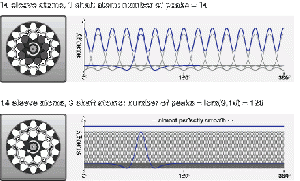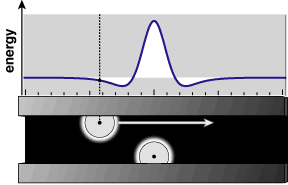File:0315pairPot.gif
Source: https://web.archive.org/web/20160314060004/http://e-drexler.com/p/04/02/0315pairPot.html
Author: Eric K. Drexler
"smoothly sliding atoms"
Associated text from Eric's Website
Stiffly supported sliding atoms have a smooth interaction potential
As shown here, an atom moving past another atom along a grazing-incidence path experiences a smooth change in energy, experiencing attraction at larger distances and repulsion if the minimum distance is small enough. This pattern of motion models situations in which both atoms are stiffly supported by moving parts.
Fourier transforms of such potentials show low amplitude spectral densities for spatial frequencies small compared to an atomic diameter [1], falling by about an order of magnitude for every cycle-per-nanometer increase in the frequency sampled. Grazing-incidence potentials create little bumpiness on a scale < 0.1nm. This is important, because if high spatial frequency components of the interatomic potential are the only contributors to energy barriers, then the barriers will be extremely small (for an example of such a situation see the discussion of symmetric molecular bearings.
This description assumes motion of atoms along fixed, linear paths, but gently curved paths give similar results. This description also ignores elastic deformation of supporting structures, which is only sometimes justifiable. If deformations are small (due to a stiff structure or a minimum distance that avoids strong interatomic repulsions), the behavior described here will be little changed. Strong repulsion between atoms with soft elastic supports can, however, produce qualitatively different behavior, in which atoms stick and jump.
Molecular mechanics force fields commonly model the interaction of uncharged, nonbonded atoms with a Buckingham (or exp−6) potential, expressible as [math]E = A [\exp(-B r) - C/r^{-6}][/math]. Electrostatic interactions affect longer-range energies, but contribute less to the high-frequency amplitude spectral density of the potential than do the components of the exp−6 potential.

File history
Click on a date/time to view the file as it appeared at that time.
| Date/Time | Thumbnail | Dimensions | User | Comment | |
|---|---|---|---|---|---|
| current | 15:05, 15 September 2021 |  | 288 × 185 (6 KB) | Apm (Talk | contribs) | Source: https://web.archive.org/web/20160314060004/http://e-drexler.com/p/04/02/0315pairPot.html <br> Author: Eric K. Drexler |
- You cannot overwrite this file.
File usage
The following page links to this file:
